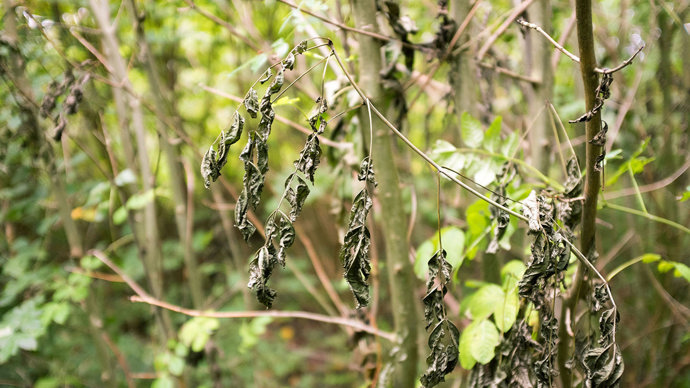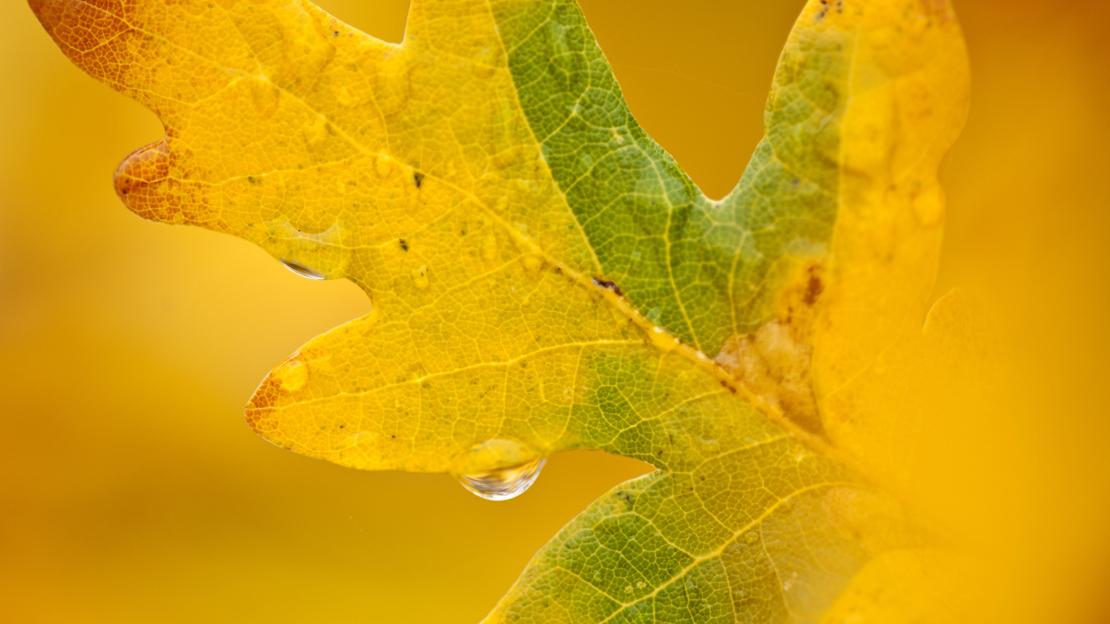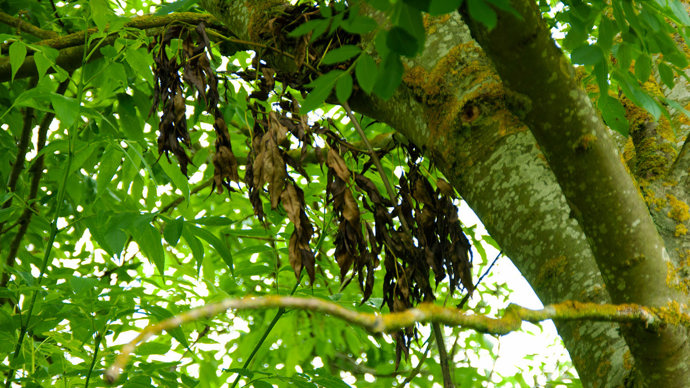Common names: ash dieback, chalara
Scientific name:
Hymenoscyphus fraxineus
What does it affect?: ash
Areas affected so far: the whole of the UK
Origin: originally from Asia, arrived in the UK via mainland Europe
Ash dieback will kill up to 80% of ash trees across the UK. At a cost of billions, the effects will be staggering. It will change the landscape forever and threaten many species which rely on ash.
Common names: ash dieback, chalara
Scientific name:
Hymenoscyphus fraxineus
What does it affect?: ash
Areas affected so far: the whole of the UK
Origin: originally from Asia, arrived in the UK via mainland Europe
Ash dieback can affect ash trees of all ages. Younger trees succumb to the disease quicker but in general, all affected trees will have these symptoms:
Ash dieback (Hymenoscyphus fraxineus) is a fungus which originated in Asia. It doesn’t cause much damage on its native hosts of the Manchurian ash (Fraxinus mandshurica) and the Chinese ash (Fraxinus chinensis) in its native range. However, its introduction to Europe about 30 years ago has devastated the European ash (Fraxinus excelsior) because our native ash species did not evolve with the fungus and this means it has no natural defence against it.

Credit: David Mark / Alamy Stock Photo
The fungus overwinters in leaf litter on the ground, particularly on ash leaf stalks. It produces small white fruiting bodies between July and October which release spores into the surrounding atmosphere.
These spores can blow tens of miles away. They land on leaves, stick to and then penetrate into the leaf and beyond. The fungus then grows inside the tree, eventually blocking its water transport systems, causing it to die.
The tree can fight back, but year-on-year infections will eventually kill it.
The ash dieback fungus wasn’t formally described until 2006, but it has been known of in Europe for about 30 years.
In the UK, ash dieback has had the most impact in the south-east of England. This is where it was first recorded in the UK back in 2012. It is unknown how long the fungus was in the area before the symptoms became apparent, perhaps some years.
We see evidence of the disease throughout the UK. However we are still at the beginning of the epidemic, so we won’t know the full impact for a while. The slow progress of the disease exacerbates this, so we need to track the sometimes subtle changes brought about by ash dieback.
The spores of this fungus can travel in the wind so it is possible that it arrived in the UK naturally however it was also inadvertently imported on ash saplings. The UK was importing thousands of ash plants from infected parts of Europe until a ban came into place in 2012. This undoubtedly sped up the spread of the disease within the UK because the disease was able to spread from areas of new planting via wind to mature trees.

Credit: Paul Sterry / WTML
It’s thought that we are going to lose significant ash populations in the UK. This is going to have a devastating impact on the landscape and the biodiversity of our woodlands, as well as a major loss in connections between habitats as we lose hedges and individual trees outside of woods.
The predicted cost of managing the diseases is high. It includes the practical expense of clearing up dead and dying trees, to the loss of its environmental services such as air purification.
That's how much ash dieback is predicted to cost British society.
There is hope on the horizon. Initial findings estimate that 1-5% of trees may show reasonable tolerance to ash dieback, but none have been found to display complete resistance. The population could eventually recover over time and studies are ongoing to investigate this.
Tolerance to the disease is complicated because a number of factors play into it including genetic traits, the health of the tree, its environment, and the number of ash dieback spores in the atmosphere.

Disease decimated the UK's elms, and now another is wiping out our ash trees. But all is not lost - with replanting and tighter controls on tree imports, we can start to repair the damage.
Support the fundEven though we’re still learning about the impacts of ash dieback, we are fighting back. We keep a close eye on the health of all our trees and woods.
As well as aiming to retain as many potentially tolerant ash trees as possible, letting nature take its course by allowing diseased ash trees to decline, we also improve the resilience of our woods to future diseases and climate change. We do this by increasing the genetic diversity of trees in existing woods. And when planting new woods, we use a mix of native tree species.
To help reduce the risk of importing new diseases and pests we only plant and sell trees that are sourced and grown in the UK and Ireland. We have also partnered with Observatree, a tree health citizen science project which trains volunteers to spot pests and diseases, helping tree health authorities identify and manage outbreaks early.
Discover more about how we manage ash dieback on our own estate.

Credit: Joe Bates / WTML
If you are and think you've spotted the signs and symptoms of ash dieback report them through TreeAlert in Britain and TreeCheck in Northern Ireland.
Gardeners and managers of parks and other sites with ash trees can help stop the local spread of ash dieback by collecting the fallen ash leaves and burning, burying or deep composting them. This disrupts the fungus's lifecycle.
If you manage a woodland you can find more guidance from the Forestry Commission.